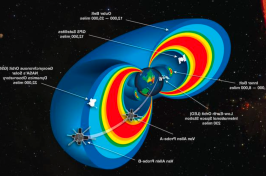For many farmers in the north, short growing seasons—such as New Hampshire’s 135-day period—and increasingly uncertain weather during shoulder seasons limit the food production capacity to sufficiently support local food systems. While indoor systems such as commercial greenhouses can help fill some of the regional systems’ needs, their energy-intensive, high-cost operations prevent most small and medium-small farmers, who represent the vast majority of farms in the northeast, from adopting them.
Scientists at the New Hampshire Agricultural Experiment Station (NHAES) at the University of New Hampshire (UNH) are developing and testing an innovative system that seeks to bring heated production systems to northeast’s small and medium-sized farms. The technology would enable farmers to adapt their existing structures (primarily high tunnels and unheated greenhouses) and use a heat-generating input that is both widely available in the region and would significantly improve regional sustainability—manure.
“New Hampshire farmers face substantial obstacles in maintaining production during the winter months,” said Md Sazan Rahman, a scientist with the NHAES and an assistant professor in agriculture, nutrition, and food systems department at the UNH College of Life Sciences and Agriculture. “So, the core idea of this project is to turn waste into a resource.”
“Manure is often seen as just a disposal problem, but it holds so much untapped heating energy potential,” Rahman added. “Our project seeks to demonstrate whether this energy can be harnessed to benefit farmers and the environment.”
A Sustainable Solution for Extending the Farming Season
Winter temperatures in Northern New England often drop well below freezing, leaving high tunnels and unheated greenhouses at just 35–45°F, which prevents local food production and supply to regional food systems during those periods. While traditional heating systems can help maintain optimal growing conditions, these solutions are often costly and out of reach for many small-scale producers.
Rahman’s team is developing and testing two manure-powered heating systems at the University of New Hampshire’s Woodman Horticultural Research Farm in Durham, New Hampshire. The research is piloting these systems by growing lettuce hydroponically, using a water-based solution rather than soil to provide nutrients to plants. The first system leverages heat generated from composting manure piles to warm a water reservoir, which then distributes heat throughout the greenhouse via a heat pump. The second system, a biofilter-based setup that reduces bacteria and pollutants found within the manure, circulates hot compost air into the greenhouse after removing harmful gases. For both systems, the research team will study the impacts on lettuce quality and quantity.
Both systems rely on manure sourced from the UNH Fairchild Dairy Teaching and Research Center and the UNH Equine Center, blended with waste hay to optimize heat production. Horse manure contributes a complementary texture and nutrient profile to the compost mix, said Rahman, helping to increase aeration and heat generation. Automatic sensors and monitoring systems will collect heat output, air quality and energy efficiency data and evaluate the systems’ overall performance.
According to the USDA, New Hampshire livestock and animal operations produce approximately 372,900 tons of manure annually, a resource that farmers have long relied on to support their operations. During the growing season, dairy farms often use manure as a natural fertilizer to enrich soil and boost crop production, while horticulture operations incorporate it into compost for fields and gardens. But in the winter, when frozen ground prevents manure from being spread, it can become more difficult to manage.
Compost-Heating Innovation at UNH: The Joshua Nelson Energy Recovery Compost Facility
In 2013, UNH’s Organic Dairy Research Farm became home to the Joshua Nelson Energy Recovery Compost Facility, a cutting-edge system that captures heat from compost piles. Using active aeration, the system pulls heat from the compost and transfers it through a patented Isobar® heat exchange system to pre-heat water for cleaning and sterilizing milk room equipment—one of the farm’s most energy-intensive tasks.
This facility not only reduces the farm’s reliance on fossil fuels but also supports UNH’s commitment to sustainable agriculture. Since its installation, the system has served as a platform for research into best practices for aeration, heat recovery and composting techniques, further advancing UNH’s leadership in renewable energy technologies for agricultural applications.
At UNH’s Organic Dairy Research Farm, an energy recovery compost facility has demonstrated how manure can be used to generate heat while producing high-quality compost, showcasing its year-round potential at a large scale. Rahman’s project builds on this approach but focuses on turning manure into a renewable energy source to heat greenhouses and extend the growing season in small-scale agricultural operations.
“Renewable solutions like this allow us to reduce dependency on fossil fuels while giving farmers the tools to make protected agriculture more efficient and sustainable,” added Rahman. “This project is an important step toward year-round crop production that benefits both farmers and the environment.”
Planning and design for the project were completed in 2024, and construction is set to begin in spring 2025. Over a three-year testing period, researchers will evaluate the systems’ impact on energy efficiency, crop yields and economic feasibility.
Md Hafizur Rahman, a PhD student in the UNH agricultural sciences program, is co-leading the project with Sazan Rahman.
“I've focused on identifying the most efficient design for both systems and on conducting an economic analysis to ensure this system is reasonable and adaptable for our regional farmers,” explained Hafizur Rahman. “By gathering temperature, air quality and energy output data, we’re studying how to finetune these systems to maximize the performance of them under real farming conditions.”
Technology Helping Farms Be a Solution to Climate Sustainability
The potential benefits of pushing the year-round production frontier for northeast farmers are unquestionable: more stable income throughout the year, potentially lower production risks in the face of weather uncertainties and increased capacity to utilize existing agricultural waste products more cost-effectively while adding an affordable, renewable heating source. The system’s hypothesized scalability could make it adaptable for farms of all sizes, from small family farms to larger commercial operations. While lettuce is the initial focus, the technology is versatile and could be used to grow other high-value crops such as tomatoes and cucumbers, added Rahman.
Additionally, utilizing manure as an energy source offers significant environmental benefits. The system being tested at UNH employs aerated composting, which differs from traditional methods by introducing oxygen through mechanical systems, such as perforated pipes and blowers, rather than manual turning. This approach can reduce methane emissions compared to conventional composting methods. Furthermore, replacing fossil fuel-based heating with renewable systems can lower greenhouse gas emissions. In the Northeast, where dairy farming and equine operations constitute a substantial segment of the agricultural sector, this system could promote more efficient waste management practices. Increased local agricultural production throughout the year may also reduce regional food systems' reliance on environmentally impactful imports.
Sazan Rahman views this project as a steppingstone toward fully sustainable greenhouses. By integrating manure-based heating with other renewable technologies, like solar and geothermal energy, farmers could achieve comprehensive environmental control with minimal resource use. The goal is to create a renewable, low-carbon greenhouse system that is both cost-effective and scalable, offering a model for protected agriculture across cold regions like New England.
“This is just the beginning,” he added. “Eventually, we hope to integrate multiple renewable energy sources and technologies, such as solar and geothermal, to build fully sustainable greenhouses for our New England farmers.”
This material is based on work supported by the NH Agricultural Experiment Station through joint funding from the USDA National Institute of Food and Agriculture (under Hatch award number 7008274) and the state of New Hampshire.
-
Written By:
Nicholas Gosling '06 | COLSA/NH Agricultural Experiment Station | nicholas.gosling@agmjbl.com




















































